
Sound Class 8 Science Chapter 13 as per NCERT Book used in CBSE and other Schools. The lesson covers the complete explanation of class 8 Chapter 13 Sound. Topics covered are sound, types of sound, sound as wave and wave types. Also, topics like human ear, Sound produced by human and animals, Sound wave propagation through states of matter, audible and inaudible sound, noise, music, instruments and Noise Pollution have been discussed. The lesson covers all important questions and NCERT solutions to book questions have also been provided for convenience of the students.
Introduction to Sound

Sound is a form of energy that produces sensation of hearing. We can also say that it is a form of energy and it comes from vibrations. These vibrations create sound waves which move through medium such as air and water before reaching our ears. All sounds are a combination of pure frequencies. A stretched rubber band when plucked, vibrates and produces sound. We have also heard a variety of sounds from sitar, violin, veena, ringing of temple bells, chirping of birds, vehicles honking in traffic, dogs barking, pressure cooker whistling, crackers bursting, rattling and breaking of objects. Also, we hear our favourite song playing in the iPod. While some of these sounds may be pleasant and soothing, some could be annoying. But all these are known as sounds.
Sound Class 8 Video Explanation
Types of Sounds
There are different types of sounds which we can hear, written as follows:
- Ticking of clock
- Humming of mosquitoes
- Barking of dogs
- Children playing in garden
- A music player sound like guitar, violin, etc. It produces pleasant sound.
- A horn
Sound is a kind of wave
Wave is defined as a periodic disturbance in a medium (air, water, and gas) that transfers energy from one particle to another.
When we throw a stone in any water body, like pond or lake, we see ripples and this stone hinders the particles of water due to which disturbances occur in a wide range at a regular interval of time.
Mechanical wave
It is that wave which needs a medium to travel. This wave does not pass through vacuum.
Electromagnetic wave
It is the wave which can travel through a medium as well as through vacuum.
Top
Longitudinal wave
It is that wave in which particles vibrate to and fro. We can also say that in this case, particles of the medium oscillate along the direction of propagation of the wave.
Top
Longitudinal waves further consist of two regions:
- Compression
- Rarefaction
Compression
It is a region where particles are closer to each other. To exemplify, when a vibrating object moves forward, it pushes and compresses the air in front of it, forming a region of high pressure called compression (C).
Compressions are the regions of high pressure and density where the particles are crowded and are represented by the upper portion of the curve called crest.
Top
Rarefaction
It is a region where particle are far from each other.
When the vibrating object moves backward, it forms a region of low pressure called rarefaction (R). A vibrating object producing a series of compressions (C) and rarefaction (R). In these waves the particles move back and forth parallel to the direction of propagation of the disturbance. Such waves are called longitudinal waves.
Rarefactions are the regions of low pressure and density where the particles are spread out and are represented by the lower portion of the curve called trough.
Top
Transversal Wave
It is the wave in which particles vibrate up and down. We can also say that it is the wave in which the particles of the medium oscillate in a direction perpendicular to the direction of propagation of the wave. Light waves are transversal waves. They do not require medium for their propagation. Light can travel through vaccum. Light is an electromagnetic and transverse wave.
The upward movement is known as crest or an elevation is called as crest. Alternatively, a downward movement in wave is called as trough or a depression in wave is said to be trough.
Sound is a kind of longitudinal wave and mechanical wave.
Top
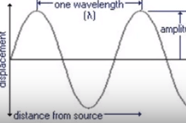 Oscillation
Oscillation
It is defined as the complete movement of particle about its mean position.
Top
Amplitude
Amplitude is the maximum displacement of a particle from its mean position in either direction. It is a measure of the intensity of the sound. Amplitude determines the loudness of sound. Loudness is proportional to the square of the amplitude.
We can also say that the amplitude of a sound wave is the height of the crest or tough. It is represented by the letter ‘A’.
The SI unit is the same as that of density or pressure.
Top
Frequency
It is defined as the number of sound waves produced per second. Frequency is expressed in hertz. Its symbol is Hz. Frequency determines the pitch of the sound. Higher the frequency, higher the pitch or it is said that the sound is shrilling. Lower the frequency, lower the shrill or pitch.
Top
Time Period
It is the time taken to complete one oscillation. Its unit is second.
Top
Wavelength
It is the distance between two consecutive crests or troughs. Its unit is centimetre (cm). It is denoted by lamda.
Top
Velocity of wave
It is the speed with which sound travels. Its unit is m/sec. It depends upon the nature of the medium through which it passes.
Conditions necessary to produce sound:
- A vibrating body
- Medium to travel
- A receiver to listen
A vibrating body
Sound is produced only when the source of sound vibrates (Oscillates) at its mean position in to and fro direction. Sometimes, vibrations can be seen and sometimes they are invisible.
Examples of a vibrating body
- We can see vibrations in ringing bell but not in case of playing harmonium.
- The tightly stretching rubber string, when plucked in the middle, shows a fast to and fro motion.
- When a tuning fork is hit on a rubber pad, a faint sound is heard but no vibrations are seen. But if you bring that tunning fork near a hanging bell, then the bell shows an oscillatory motion.
- When the source of sound vibrates it collides with the particles present in air.
- These particles after collision further collide with other particles and this continues in form of a chain carrying the energy until the energy of particles becomes too feeble to collide further and propagate the sound.
- As we move away from the source of the sound, the sound becomes feeble. Like the person standing on the railway track experiences the maximum or extreme sound as compared to the one who lives in the colony near the railway track.
To show that sound needs a medium to travel, let us take an example-
- When current is switched on bell starts ringing and we can easily here the sound of ringing bell.
- But as we start removing air by means of vacuum pump, the sound of ringing bell goes on becoming fainter or lighter. Then finally, when there is no air left inside, we will be unable to hear the sound of the bell or we can say that it will stop ringing.
- The most important necessities are that the body should vibrate so that sound can be produced. The second most important source is medium through which receiver can heard. The third most important source is receiver. Receiver is the one who can hear the sound.
Characteristics of sound
There are different characteristics of sound which are as follows:
- Loudness
- Pitch
- Quality
- Intensity
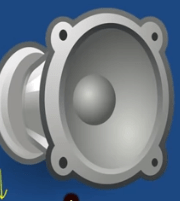 Loudness
Loudness
It is a characteristic of sound, the degree of sensation of sound. It depends upon amplitude. Amplitude determines the loudness of sound. Loudness is proportional to the square of the amplitude of the vibrating body which produces sound. More is the amplitude, louder is the sound. It is measured in unit ‘decibel’.
The more the amplitude of vibration, louder the sound. The lesser the amplitude of vibration, the sound gets feeble.
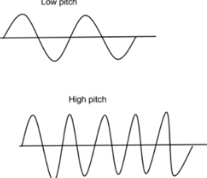 Pitch
Pitch
It is the property that determines the shrillness (sharpness) or depth of sound. It depends upon the frequency. More the frequency, more the voice is shrilled. Less the frequency, deep is the sound. For example: a baby’s voice has more frequency and thereby, it is shriller than an adult’s voice.
 Quality
Quality
It is the property by which one can distinguish between two different sounds of same pitch and loudness. Like in a dark room where there is no light and 100 people are present, we can easily recognize the sound of our friend among all the people due to the particular quality of its sound.
 Intensity
Intensity
It is defined as the number of sound waves passing 1 meter square area in one second. It depends upon the square of amplitude.
Sound can travel through all 3 states of matter that is solids, liquids and gases.
Speed of sound depends upon the density (density is defined as mass per unit volume) of medium (it increases with increase in density of mediums).
Speed of sound is maximum in solids and least in gases as particles are closer in solids. So, transfer of sound energy occurs faster. Speed of sound in air is 340 metre per second.
Question: Why speed of sound is more on a humid day as compared to a dry day?
Answer: The speed of sound is more on a humid day as compared to a dry day because on a humid day, particles are comparatively closer, so, the transfer of energy occurs faster.
Question: Let us compare speed of sound and speed of light in air?
Answer: Light travels faster than sound. The speed of light is 3 x 10⁸ m/sec.
Speed of sound is 340 m/sec.
Question: On a stormy day, why lightning is seen first and thunder is heard later?
Answer: On a stormy day, we usually see the lightning first and thunder is heard later because in air, the speed of light is faster as compared to the speed of sound.
Question: “Sound travels through a medium, it cannot travel in a vacuum”. Justify the statement.
Answer: Sound propagates by causing the particles in the medium to vibrate. A vibrating source transfers the vibrations to the surrounding medium, which can be solid, liquid or gaseous. The resulting vibrations create varying pressure regions by compressing and decompressing the particles in the medium, and through this process of compression and decompression, sound waves propagate through the medium. During the propagation of sound, the particles of the medium receive these vibrations and transfer them to the surrounding particles, allowing sound to travel.
In a vacuum, there are no particles that can transfer and carry vibrations, so sound cannot travel.
Question: A pendulum oscillates 50 times in 6 seconds. Find its time period and frequency?
A pendulum makes 27 oscillations in 3 seconds. what is the frequency of the pendulum?
Answer: As we know that the number of oscillations made by a pendulum in 1 second is called its frequency.
Now,
In 6 seconds, pendulum makes – 50 oscillations
In 1 second, pendulum makes – 50/6 = 25/3 oscillations
Thus, the frequency of this pendulum is 25/3
Time period T = 1/F = 3/25
Question: How is a sound produced?
Answer: Sound is produced when something vibrates. The vibrating body causes the medium (water, air, etc.) around it to vibrate. Vibrations in the air are called travelling longitudinal waves, which we can hear. Sound waves consist of areas of high and low pressure called compressions and rarefactions, respectively.
Question: What are the three characteristics of sound?
Answer: Following are some of the characteristics of sound:
- Sound travels in longitudinal waves.
- The amplitude of a sound determines its volume (loudness).
- Tone is a measure of the quality of a sound wave.
- Sound travels faster in a hot medium, or in a solid.
Sound produced by man
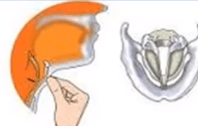 Sound produced by man is through a voice box called larynx, it consists of two flap – like ligaments called vocal cords with a narrow slit spacing them.
Sound produced by man is through a voice box called larynx, it consists of two flap – like ligaments called vocal cords with a narrow slit spacing them.
When we speak, air is forced out (exhaled). This exhaled air forces the vocal chords to vibrate due to which sound is produced.
Length of vocal cord in males is 20mm and females is 15mm. That is the reason that females and males have different sounds.
Top
 Sound produced by animals
Sound produced by animals
Animals produce a wide range of sounds. Like sparrow, lion, elephant all of them have different sounds. Many animals use lungs to blow air that make their vocal cords vibrate and sound is produced.
Lower organisms use their wings to produce buzzing sound.
Fish use airbladder to produce sound.
Let us conduct an activity to show that sound can travel through liquids
- For this activity, we need to take a bucket or bathtub.
- Then Fill the bucket or bathtub with water.
- Take a small bell in hand.
- Then we need to shake the bell inside water to produce sound.
- Make sure it does not touch the body of bucket.
- Now place your ear gently on water surface.
- At last, we will be able to hear the sound of ringing bell. This activity proves that sound can travel through liquid.
Question: Why astronomers fail to hear the sound of each other on the surface of the moon?
Answer: Astronomers fail to hear the sound of each other while they are on the surface of the moon because there is no air present on the moon and we know that sound cannot travel through vacuum. It needs medium to travel.
Question: How whales and dolphins are able to communicate?
Answer: Whales and dolphins are able to communicate in liquids as sound can travel through liquids.
Question: State the functions of the human ear.
Answer: While hearing is the obvious function of the ear, it is the primary organ for our sense of balance as well. Physically, the ear consists of three parts: the outer ear, the middle ear, and the inner ear. The outer and middle ears mostly collect and transmit sound.
Question: Why are the voices of men, women and children different?
Answer: The vocal cords in men are about 20 mm long. In women, these are about 15 mm shorter. Children have very short vocal cords. This is the reason why the voices of men, women and children are different.
Question: Who has a high pitched sound, a man or a woman? What is the reason for the difference between the two?
Answer: One of the first and most obvious biological differences between men and women’s speech is the pitch. This is partly because men are normally larger than women (sexual dimorphism), which means their vocal folds are larger. Thus, men have lower pitched voice.
Question: Is there any animal that can hear the sounds of frequencies higher than 20,000Hz? For what purpose is it used?
Answer: A bat can hear the sounds of frequencies higher than 20,000Hz. Bats produce ultrasonic sound during screaming. These ultrasonic waves help the bat to locate its way and its prey.
Top
Audible and Inaudible sound
Audible sound: It is the range of the frequency of sound that can be heard by humans. The human ear can detect sounds in the range of 20Hz-20KHz.
Inaudible sound: It is the range of the frequency of sound that cannot be heard by humans. The range below 20Hz and greater than 20KHz cannot be heard by the human ear.
Question: What is Galton whistle?
Answer: These are the special whistles that produce sound of frequency higher than 20,000 Hertz. Dogs have the ability to hear it but humans cannot. Ultrasound scans produce sounds in this range. It is used for investigation purpose.
Top
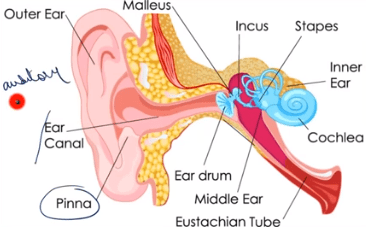 Human ear
Human ear
It is an organ that helps in hearing.
It is divided into 3 parts:
- Outer
- Middle
- Inner
Outer part: It consist of ear pinna, auditory canal, and ear drum. The outer ear is the most external portion of the ear called the pinna or auricle, the ear canal.
Middle part: The middle ear is an air-filled cavity. It includes three interlocked bones: the malleus (or hammer), incus (or anvil), and stapes (or stirrup).
Inner part: This contains the sensory organs for balance and motion, with the help of semicircular canals. This also contains cochlea, the sensory organ for hearing. Inner ear consists of eustachian tube.
A coiled organ filled with fluid (Cochlea). The sound produced by a vibrating body travels in the form of vibrations. It is collected by ear pinna and it directs into ear canal where it travels and hits the ear drum.
On receiving vibrations, the ear drum starts vibrating. Once the ear drum vibrates, it passes vibrations to 3 interlocked bones of middle ear which further increases the amplitude of vibrations.
Inner ear vibrations are received by a coiled organ. On receiving the vibrations its fluid also starts vibrating and sensory cells present in them transform the vibrations into electrical signals which are carried by auditory nerve to brain for interpretation and understanding.
Time to check your knowledge by answering the following questions-
Fill in the blanks with suitable words –
- A low pitch sound is called a_____
- The sound which is pleasing to the ear called _______sound.
- You cannot hear sounds below _______Hz. These are called ______.
- What is the SI unit of frequency in ________.
- The hammer, anvil and stirrup are three tiny bones present in the ______.
- Veena and sitar are examples of _______ instruments.
Answers:
- sound
- music
- 20, infra – sonic
- Hz
- ear
- musical
Mark the following statements as true or false-
- The SI unit of loudness is Hertz.
- Sound cannot travel in a vacuum.
- The unpleasant or unwanted sound is termed as music.
- Sound can be produced by beating an object irrespective of whether these are vibrating or not.
- Excessive noise can cause deafness.
- Curtains, cushions and rugs absorb sound.
- false
- true
- false
- false
- false
- true
Types of sound
There are two types of sound which are as follows:
- Music
- Noise
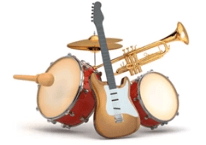 Music
Music
It is the sound that gives pleasant effect or soothing effect. It is used for relaxation and for enjoyment.
Musical Instrument: An instrument that produce a musical sound. Like guitar, drums, flute.
A musical instrument uses the following things to produce a pleasant effect:
- Vibrating strings
- Vibrating column of air
- Vibrations in wood, metal or stretched membranes
There are 3 main types of instruments:
- Stringed instruments
- Wind instruments
- Percussion musical instruments
Stringed instruments
These are the instruments which use strings to produce a pleasant sound. These can be plucked, bowed or struck. The instruments with plucked strings have varied lengths. The examples of these include sitar, violin, guitar, etc. These all instruments are bowed to produce sound of different pitches.
Here are few other examples:
Violin: Violin produces the sound of highest pitch.
Double bass: Double bass produces the sound of lowest pitch.

Wind instruments
These instruments are mainly made of brass and wood but sometimes they can be made of silver. They all differ due to the varied length of air column. For example: Flute, Shehnai, Been.
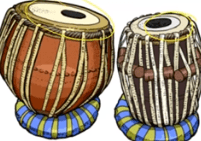 Percussion Instruments
Percussion Instruments
These instruments struck themselves as they include vibrating membranes as used in drums of various kinds. For example: Tabla and dholak.
Top
 Noise
Noise
It is defined as the sound that is unpleasant and has an irritating effect. For example: Sound of a horn, sound near the site of construction work, sound of an aeroplane, etc.
Top
Noise pollution
It is defined as the contamination of air with unpleasant and irritable effect. Loud and excessive sound is unbearable for our ears and is called noise. The unwanted and excessive sound in our environment creates noise pollution. Sounds of crackers, factories, vehicles, desert coolers, air conditioners, aeroplane, transistors or television with high volume, loudspeakers, etc. create sound pollution.
Major causes of noise pollution are as follows:
- Sound of vehicles
- Explosions including bursting of crackers. Like on Diwali, different types of crackers are fired and each cracker has different sound and causes noise pollution.
- Sounds of machines in Industries.
- Sounds of loudspeakers. Let us suppose, in a fare, if someone is lost, loud speakers are used to find him because in fare, there are a lot of people and a lot of noise. To make our sound audible to the huge crowd, we need to use loudspeakers. This obviously causes pollution.
- Playing transistors, radio at high volume.
- Sound of kitchen appliances.
- Sound of desert coolers or ACs.
 Harms of Noise pollution are as follows:
Harms of Noise pollution are as follows:
- Noise pollution leads to lack of sleep. Let us suppose if there is any marriage party going on in our surroundings and they use loud speakers. Then, we will not be able to sleep due to extremely high sound of speakers.
- It leads to Hypertension or we can say that high blood pressure.
- It also leads to anxiety.
- More health problems.
- Extreme or loud sounds cause impairment of hearing. This impairment can either be total hearing impairment or partial impairment.
Measures to limit Noise pollution are as follows:
- To limit noise pollution, we can instal silencing devices in aircraft engines, vehicles, etc.
- Noise producing industries, airports, bus and transport terminals and railway stations to be located far from residential areas.
- We need to minimize the use of automobiles and horns.
- TV, music system should be operated at low volume.
- We should plant trees along roads and buildings.
- Community law enforcers should check the misuse of loudspeakers, processions, outdoor parties and discos, as well as public announcement systems. Community laws must create silence zones near schools/ colleges, hospitals etc.
NCERT Book solutions
Multiple choice questions
1. Eardrum is a part of which of the following-
a. Sound producing organ
b. Skeletal system
c. Hearing organ
d. Reproductive organ
2. What is the hearing range of human ear?
a. 20 Hz to 20,000 Hz
b. Less than20 Hz
c. More than 20,000 Hz
d. 20 Hz to 25,000 Hz
3. What is the other name of voice box ?
a. Stomach
b. Heart
c. Larynx
d. Mouth
4. Large amplitude of sound vibrations will produce:
a. Loud sound
b. Meak sound
c. Slow sound
d. Shreak
5. The pitch of sound depends on which of the following?
a. frequency
b. amplitude
c. both of these
d. none of these
6. Sound is kind of
a. Work
b. Energy
c. Force
d. None
7. To and fro motion of an object is called as?
a. Waves
b. Amplitude
c. Vibration
d. All of the above
8. Voice box or larynx of human process
a. Sound
b. Wind
c. Loudness
d. None
9. In which of the following sound propagates maximum ?
a. Gas
b. Liquid
c. Solid
d. All
10. Noise pollution is harmful for
a. Human
b. Cat
c. Bird
d. All
ANSWERS
- C
- A
- C
- A
- A
- B
- C
- A
- C
- D
Question: Explain harmful effects of noise pollution?
Answer: The harmful effects of noise pollution are as follows:
- It causes deafness
- It causes mental illness
- It causes headache and high blood pressure.
- It causes insomnia.
Question: What is the difference between noise and music? Can music become noise sometimes?
Answer: The sound which is unpleasant for our ears is called noise while music is the sound which is pleasant for our ears. Music becomes noise sometimes, when it crosses the bearable range of sound for our ears.
Question: Lightning and thunder take place in the sky at the same time and at the same distance from us. Lightning is seen earlier and thunder is heard later. Can you explain why?
Answer: The speed of light is more than that of sound. Due to more speed the light reaches us before the sound does. So Lightning is seen earlier and thunder is heard later.
Question: List sources of noise pollution in your surroundings.
Answer: There are different sources of noise pollution which includes honking of horns, loudspeakers, loud sound of machines in factories, loud sound of TV, radio, domestic etc.
Question: Why should we never put a sharp, pointed or hard, thing into our ear?
Answer: We should not put anything like pin, pencil or pen etc. inside our ears because they can hurt the eardrum and can make a person completely deaf.
Question: Why are we not able to hear the screams of a bat?
Answer: Bat produces ultrasonic sound during screaming and that is the frequency of a sound is more than 20,000Hz, it cannot be heard by us. The sound of these frequencies is inaudible. So we are not able to hear the screams of a bat.
Question: Write the full form of dB ?
Answer: Decibel is the full form of dB.
Question: What is the name the substance which vibrates in a flute to produce sound?
Answer: Flute uses air as the primary vibrating medium for the production of sound.
Multiple Choice Questions
1. The speed of sound in solids is the speed of sound in liquids.
(a) same as
(b) less than
(c) greater than
(d) sometimes greater and sometimes smaller
Answer: (c) greater than
2. Bats detect the obstacles in their path by receiving the reflected?
(a) infrasonic waves
(b) electromagnetic waves
(c) radio waves
(d) ultrasonic waves
Answer: (d) ultrasonic waves
3. Which of the following is not a characteristic of a musical sound?
(a) Pitch
(b) Quality
(c) Wavelength
(d) Loudness
Answer: (a) Pitch
4. Sound waves do not travel through which of the following?
(a) solids
(b) gases
(c) liquids
(d) vacuum
Answer: (d) vacuum
5. Which one of the following can hear an infrasonic sound?
(a) Dog
(b) Rhinoceros
(c) Bat
(d) Humans
Answer: (c) Bat
6. What kind of musical instrument is a sitar?
(a) String
(b) Membrane
(c) Wind
(d) None
Answer: (a) String
7. In a ‘dholak’ sound is produced due to?
(a) stretched membrane
(b) air column
(c) stretched strings
(d) the vibration of air
Answer: (a) stretched membrane
8. The pitch of sound depends on the which of the following of the vibrating body?
(a) amplitude
(b) frequency
(c) noise
(d) the medium of propagation
Answer: (b) frequency
9. The human ear can hear sounds having frequency range:
(a) between 200-20,000Hz
(b) between 200-2000Hz
(c) between 20-2000Hz
(d) between 20-20,000Hz
Answer: (d) between 20-20,000Hz
10. What is the SI unit of time period is
(a) second
(b) minute
(c) hour
(d) nanosecond
Answer: (a) second
11. Vibrations inside the ear are amplified by the three bones namely the in the middle ear.
(a) Hammer, anvil and stirrup
(b) Hammer, cochlea and stirrup
(c) Hammer, anvil and pinna
(d) Auditory bone, anvil and stirrup
Answer: (a) Hammer, anvil and stirrup
12.What is the SI unit of pitch ?
(a) Hertz
(c) metre
(c) m/sec
(d) second
Answer: (a) Hertz
Fill in the blanks:
- Loudness of sound is depends on …………….
- Sound absorbing materials are required in auditoria to avoid ……………
- The property of sound that is used by animals to find their way and locate their food is………..
- The two kinds of sounds we cannot hear are ……………. And ………….
- ……………… of any kind is the principle source of production of sound.
- What is the name of the…………… instrument used in the laboratory to produce sound of a fixed frequency.
- Sound needs a …………….. medium for propagation.
- The vibrations of a simple pendulum are also known as ……………….
- A soft board will………………… most of the sound falling on it.
- The number of vibrations completed in one second is known as ………….
- ……………. is proportional to the square of amplitude.
- If the thickness of the vibrating string is increased its pitch ………………
- Speed of sound highest in …………… medium.
- The range of audible frequency for the human ear is……………
- Noise is produced by……………..
Answers:
- Amplitude
- Noise pollution
- Echo
- Infrasonic and Ultrasonic
- Vibrations
- Tuning fork
- Material
- Oscillations
- Absorb
- Frequency
- Loudness
- Decrease
- solid
- 20Hz to 20,000Hz
- Irregular and non-periodic vibrations

